A View from the Atlantic Sobey Art Award - Art Gallery of Nova Scotia
A View from the Atlantic Sobey Art Award - Art Gallery of Nova Scotia
A View from the Atlantic Sobey Art Award - Art Gallery of Nova Scotia
- No tags were found...
Create successful ePaper yourself
Turn your PDF publications into a flip-book with our unique Google optimized e-Paper software.
24AGNS welcomesNations in a CircleNations in a Circle is an organizationformed, “to presentand promote <strong>the</strong> art, cultureand traditions <strong>of</strong> First NationsPeoples.” Their eight memberboard is made up <strong>of</strong> bothAboriginal and non-aboriginalartists, and you may be familiarwith <strong>the</strong>ir annual Fall showcasewhich presents some <strong>of</strong> NorthAmerica’s finest established andemerging artists in Halifax.Part <strong>of</strong> NIAC’s mission is “toensure growth, respect andappreciation for <strong>the</strong> creativeexpression <strong>of</strong> First Nations andAboriginal peoples <strong>of</strong> <strong>Atlantic</strong>Canada through our arts, cultureand traditions,” and as such <strong>the</strong>yhave long had a relationshipwith <strong>the</strong> Programming andEducation departments <strong>of</strong> <strong>the</strong><strong>Gallery</strong>. Recently, our associationhas grown even closer withtwo events.Last Fall, <strong>the</strong> AGNS was approachedby Cathy Martin andMarlene Joudry, who werelooking for <strong>of</strong>fice space that<strong>the</strong>ir organization could use asa headquarters in Halifax. Afterour meeting, <strong>Gallery</strong> staff did aclose examination <strong>of</strong> our <strong>of</strong>ficesituation (tight at <strong>the</strong> best <strong>of</strong>times!) and decided we had an<strong>of</strong>fice that could be used on ashared basis. This was acceptableto NIAC and this past May,during Aboriginal Awarenessweek, <strong>the</strong>y <strong>of</strong>ficially moved into<strong>the</strong>ir <strong>of</strong>fice within <strong>the</strong> AGNS.NIAC members will be usingthis <strong>of</strong>fice space throughout<strong>the</strong> year to conduct meetingsand have a home base herein Halifax, in conjunction withano<strong>the</strong>r <strong>of</strong>fice in Truro. It gives<strong>the</strong>m a great location for <strong>the</strong>irmeetings, and provides <strong>the</strong>AGNS with easy access to somewonderful and knowledgeableartists who <strong>of</strong>fer unique perspectivesand insights into <strong>the</strong>AGNS First Nations collectionsand exhibitions. We hope thiswill be just <strong>the</strong> first <strong>of</strong> many collaborationsbetween <strong>the</strong>se twoorganizations.The second event was <strong>the</strong> briefthree-week exhibition in May,Keepers <strong>of</strong> <strong>the</strong> Eastern Door, that<strong>the</strong> AGNS hosted for its <strong>Nova</strong><strong>Scotia</strong> debut prior to its presentationto an internationalaudience at <strong>the</strong>2010 Winter Olympicsin Vancouver. The<strong>Atlantic</strong> Aboriginalwork in this exhibitionwas selected incooperation with <strong>the</strong>Vancouver OlympicsCommittee (VANOC)and <strong>the</strong> Mi’kmaqAssociation for CulturalStudies (MACS), andshowcased <strong>the</strong> works <strong>of</strong>ten <strong>Atlantic</strong> Aboriginalartists.The artists includedNed Bear (Maliseet, St. Mary’sFirst Nation, NB); Shirley Bear(Maliseet, Tobique First Nation,NB); Dozay Christmas (Maliseet,Membertou, NS – originally <strong>from</strong>Tobique First Nation, NB); PeterClaire (Mi’kmaq, Elsitpotog FirstNation, NB); Charles Doucette(Mi’kmaq, Potlotek First Nation,NB); Jerry Evans (Mi’kmaq,St. John’s, NL); Gerry Gloade(Mi’kmaq, Millbrook First Nation,NS); Todd Labrador (Mi’kmaq,Acadia First Nation, NS); MaryLouise Martin (Mi’kmaq, Mill-Alan Syliboy, Tuft’s Cove Survivor, 1999, Acrylic, watercolour pencil, ink, and photo transfer on illustration board, 76.0 x 101.5cmPurchased with funds provided by <strong>the</strong> Canada Council for <strong>the</strong> <strong>Art</strong>s Acquisition Assistance Program and <strong>the</strong> AGNS <strong>Gallery</strong> Shop, 1999Edward (Ned) Bear, Meskocipayiwak, 2002, Yellowbirch, horse hair, bear fur, 43.0 x 23.5 x 11.0 cmPurchased with financial support <strong>of</strong> <strong>the</strong> CanadaCouncil for <strong>the</strong> <strong>Art</strong>s and funds provided by <strong>the</strong> <strong>Art</strong>Sales and Rental Society, Halifax, <strong>Nova</strong> <strong>Scotia</strong>, 2005brook First Nation, NS); and AlanSyliboy (Mi’kmaq, Millbrook FirstNation, NS).From Ned Bear’s striking maskswith exaggerated features accentuatedby <strong>the</strong> grain <strong>of</strong> <strong>the</strong>wood, exuding power and mystery,to Dozay Christmas’ homageto three important leaders:Rita Joe, Oliver Polches, andPeter Wilmot, and <strong>the</strong> importance<strong>of</strong> Wampum in keeping<strong>the</strong>ir history alive and strong,to <strong>the</strong> turtle drum by ToddLabrador, <strong>the</strong> works embraced<strong>the</strong> spirit <strong>of</strong> <strong>the</strong>ir culture andcommunities and presented <strong>the</strong>diverse talents <strong>of</strong> <strong>the</strong>se artistsworking through traditional andcontemporary media and techniques.Although <strong>the</strong> exhibitionperiod was brief due to <strong>the</strong>need to have <strong>the</strong> works shippedto Vancouver, everyone felt itwas vital that <strong>the</strong> first exhibition<strong>of</strong> <strong>the</strong>se selected works be in<strong>Atlantic</strong> Canada. The <strong>Art</strong> <strong>Gallery</strong><strong>of</strong> <strong>Nova</strong> <strong>Scotia</strong> was proud to be<strong>the</strong> first venue for this show, andwe look forward to many futurecollaborations with <strong>the</strong> artistsand <strong>the</strong>se associations.Shannon Parker,Curator <strong>of</strong> CollectionsndaatjeCollectionCollections are built for a myriad<strong>of</strong> reasons. But at <strong>the</strong> core isalways one thing: passion andcommitment. The Ondaatjecollection <strong>of</strong> Canadian art isboth a reflection <strong>of</strong> <strong>the</strong> tastes<strong>of</strong> one man and <strong>of</strong> <strong>the</strong> mandate<strong>of</strong> one institution. Made up <strong>of</strong>works donated <strong>from</strong> a personalcollection and <strong>of</strong> works whoseacquisition was supported inwhole or in part by Sir ChristopherOndaatje, <strong>the</strong> collectioncreates a valuable portrait <strong>of</strong><strong>the</strong> donor and his relationshipto this institution.The caliber <strong>of</strong> <strong>the</strong> OndaatjeCollection is readily apparent.Even among <strong>the</strong> o<strong>the</strong>r exquisitepieces <strong>of</strong> <strong>the</strong> Collection, TomForrestall’s impeccable eggtempera on masonite shapedpainting,Island in <strong>the</strong> Ice, standsout as one <strong>of</strong> <strong>the</strong> highlights. Anative <strong>of</strong> Dartmouth, and one <strong>of</strong><strong>the</strong> leading figures associatedwith <strong>the</strong> visual arts <strong>of</strong> <strong>the</strong> <strong>Atlantic</strong>region, Forrestall’s subjectmatter reflects his unwaveringbelief in <strong>the</strong> values and qualities<strong>of</strong> life in <strong>the</strong> <strong>Atlantic</strong> Provinces.His work has been exhibited inprominent galleries continuallysince <strong>the</strong> mid-sixties and is representedin every major publiccollection in this region and beyond.Forrestall was introducedto egg tempera painting by <strong>the</strong>world-renowned Alex Colville,who toge<strong>the</strong>r with ChristopherPratt and Mary Pratt, form acoterie <strong>of</strong> “magic realist” Eastcoastpainters, making thispiece a valuable addition to<strong>the</strong> <strong>Art</strong> <strong>Gallery</strong> <strong>of</strong> <strong>Nova</strong> <strong>Scotia</strong>’sPermanent Collection.In conjunction with <strong>the</strong> stunningForrestall work, <strong>the</strong> OndaatjeCollection features two brilliantpaintings by <strong>the</strong> influential AlexColville, Three Girls on a Wharfand, possibly one <strong>of</strong> his greatestworks, Ocean Limited. Colville’sstyle is easily recognizable,instantly grabbing <strong>the</strong> viewer’sattention. Employing his meticuloustechnique based onorder, harmony, and naturalism,Colville’s striking works depictan altered reality in which <strong>the</strong>known and familiar collide with<strong>the</strong> unknown and mysterious,while appearing to be in perfectunison. A Canadian war artistduring <strong>the</strong> Second World War,Colville’s experiences in Europeduring that horrific time arepresent in his artwork in <strong>the</strong>form <strong>of</strong> absence. His paintingsexhibit a disconnect betweenwhat is seen and what is sensed,a medium through which thisextraordinary artist explores <strong>the</strong>notion <strong>of</strong> what it is to be humanand what it means to live in thischaotic world.The outstanding Ondaatje collectionalso includes works byinstrumental Canadian artists<strong>from</strong> outside <strong>the</strong> <strong>Atlantic</strong> region.For example, Composition andFigure Légendaire, two paintingsby <strong>the</strong> radical Québequois abstractartist, Paul-Émile Borduas,form part <strong>of</strong> <strong>the</strong> collection.When Borduas showed 45 <strong>of</strong>his gouaches at <strong>the</strong> ErmitageThéâtre in Montréal during <strong>the</strong>spring <strong>of</strong> 1942, he gave rise to<strong>the</strong> birth <strong>of</strong> Les Automatistes.This movement, inspired by abstractrealism, initially consisted<strong>of</strong> Borduas and a few followers<strong>from</strong> among his students at <strong>the</strong>École du Meuble. The group<strong>of</strong> young artists engaged in afree exchange <strong>of</strong> ideas, seekingto paint with pure psychicautomatism as did <strong>the</strong> stream<strong>of</strong>-consciousnesswritings <strong>of</strong>André Breton. The influence <strong>of</strong>Borduas and Les Automatisteswas widespread, working itsway into o<strong>the</strong>r forms <strong>of</strong> artisticexpression such as drama, poetry,and dance.Ano<strong>the</strong>r <strong>of</strong> Quebec’s foremostpainters to emerge during <strong>the</strong>twentieth century is Jean PaulLemieux. The AGNS is fortunateenough to have three <strong>of</strong> <strong>the</strong> artist’sspectacular works as part <strong>of</strong>its permanent collection thanksto Sir Christopher Ondaatje.Lemieux’s paintings are <strong>of</strong>tensombre; possessing a distinctlynor<strong>the</strong>rn quality in which starkhorizon lines, expansive snowcovered fields, and a sense <strong>of</strong>quiet solitude permeates <strong>the</strong>works. These characteristicsare perfectly embodied in Lemieux’spainting Le Découvreur,ano<strong>the</strong>r <strong>of</strong> <strong>the</strong> Ondaatje Collectionhighlights.Folk sculpture in <strong>Nova</strong> <strong>Scotia</strong>grew out <strong>of</strong> utilitarian needsand <strong>the</strong> individual situations <strong>of</strong><strong>the</strong> early settlers. By 1850, as<strong>Nova</strong> <strong>Scotia</strong>n society began totake shape, prosperity broughtwith it a cultural resurgence anda <strong>Nova</strong> <strong>Scotia</strong>n spirit. A fine example<strong>of</strong> folk art <strong>from</strong> this earlyperiod is James Hertle’s BlackFigure in a Dancing Position, c.1865. During <strong>the</strong> mid-19 th Century,Hertle worked as a ship’scarver at Williams’ Shipyard inDartmouth. He is known to haveproduced several ship’s figureheadsand o<strong>the</strong>r carvings whileworking <strong>the</strong>re. This sculpture isone <strong>of</strong> only three known knownlife-size figures by Hertle, and itis <strong>the</strong> only one <strong>of</strong> <strong>the</strong>se carvingsincluded in a Halifax exhibition.This figure’s black, yellow andred polychrome paint is original,and <strong>the</strong> position <strong>of</strong> <strong>the</strong> handsand feet indicate that <strong>the</strong> figureis beginning to perform a dance.One <strong>of</strong> <strong>the</strong> finest nineteenthcenturycarvings anywhere, itforms an intricate part <strong>of</strong> <strong>the</strong>Ondaatje Collection, as it truly isan <strong>Atlantic</strong> treasure.Many o<strong>the</strong>r Canadian nationalartists are featured in TheOndaatje Collection includingWilliam Kurelek, Louise Scott,A. Y. Jackson and o<strong>the</strong>rs. As SirChristopher says, “These were<strong>the</strong> paintings that we collectedand loved <strong>the</strong> most while wewere growing up in Canadaduring <strong>the</strong> 1960s, 1970s and1980s. They are a mosaic <strong>of</strong> <strong>the</strong>country’s growth, <strong>the</strong> artists’impressions at that time, andour own emotional lives. This is<strong>the</strong> first time all <strong>the</strong>se works <strong>of</strong>art have been displayed in <strong>the</strong>same room – where <strong>the</strong>y oughtto be as part <strong>of</strong> The <strong>Art</strong> <strong>Gallery</strong> <strong>of</strong><strong>Nova</strong> <strong>Scotia</strong> and part <strong>of</strong> our ownpermanent National heritage.”Over <strong>the</strong> past fifteen years JohnGreer’s sculpture Origins, hascome to be a familiar landmarkin downtown Halifax. This workmakes reference to several pastcultures and myths, to architecturalhistory and to <strong>the</strong> humanhand. Underlying <strong>the</strong>se is a referenceto <strong>the</strong> basic human needfor order. Permanently installedin <strong>the</strong> Ondaatje courtyard,adjacent <strong>the</strong> main entrance <strong>of</strong><strong>the</strong> AGNS, this attractive andengaging piece has grown intoan emblem for <strong>the</strong> <strong>Art</strong> <strong>Gallery</strong><strong>of</strong> <strong>Nova</strong> <strong>Scotia</strong> and stands as asymbol for <strong>the</strong> ongoing partnershipbetween Sir ChristopherOndaatje and <strong>the</strong> <strong>Gallery</strong>. Theworks mentioned above formonly a small sampling <strong>of</strong> <strong>the</strong>pieces that make up this wonderfulbody <strong>of</strong> work, <strong>the</strong> fruit <strong>of</strong>a passion for Canadian art.ART GALLERY OF NOVA SCOTIA FALL JOURNAL 2009 ART GALLERY OF NOVA SCOTIA FALL JOURNAL 2009 25<strong>the</strong>A view <strong>of</strong> <strong>the</strong> Christopher Ondaatje <strong>Gallery</strong> at <strong>the</strong> <strong>Art</strong> <strong>Gallery</strong> <strong>of</strong> <strong>Nova</strong> <strong>Scotia</strong>



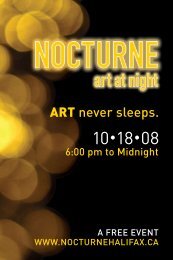
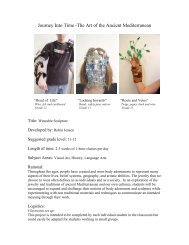
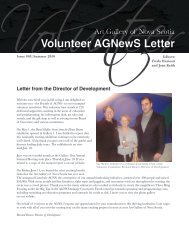

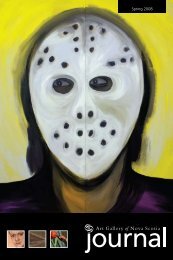

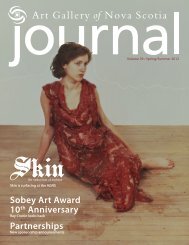
![Elizabeth Bishop - Crazy Quilts and Stories [pdf] - Art Gallery of Nova ...](https://img.yumpu.com/43102277/1/190x245/elizabeth-bishop-crazy-quilts-and-stories-pdf-art-gallery-of-nova-.jpg?quality=85)
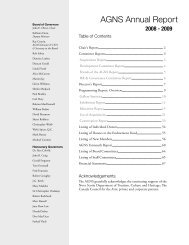
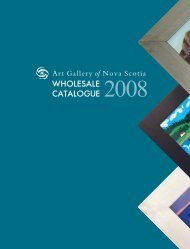

![Senior High lesson plan brochure [pdf] - Art Gallery of Nova Scotia](https://img.yumpu.com/36529943/1/190x146/senior-high-lesson-plan-brochure-pdf-art-gallery-of-nova-scotia.jpg?quality=85)

![Junior High lesson plan brochure [pdf] - Art Gallery of Nova Scotia](https://img.yumpu.com/35457408/1/190x146/junior-high-lesson-plan-brochure-pdf-art-gallery-of-nova-scotia.jpg?quality=85)